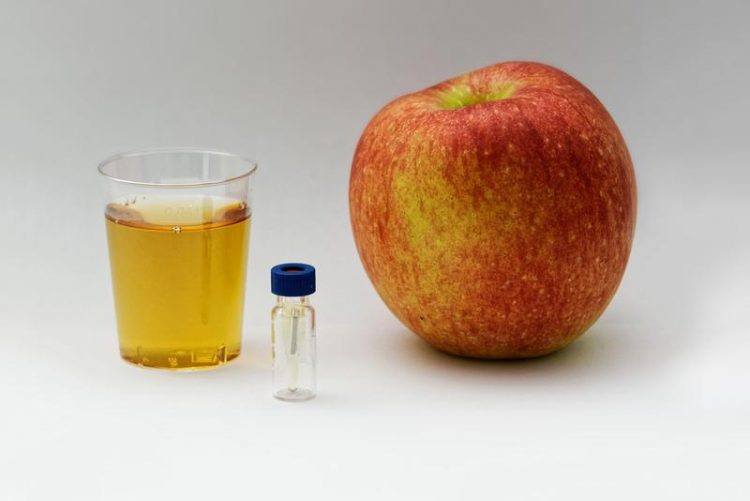Food profilers develop new methodological approach for food analysis: Better food quality control

The simultaneous analysis of odorants and tastants could simplify and accelerate the quality control of food in the future. Image: A. Dunkel / LSB / TUM
Whether a food tastes good or not is essentially determined by the interaction of odors and tastants. A few trillionths of a gram per kilogram of food is enough to perceive some odorants. Tastants, on the other hand, we only recognize at significantly higher concentrations.
In order to guarantee consistent sensory quality, it is very important for manufacturers to know and control the characteristic odor and taste profiles of their products from the raw material to the finished product. This requires a fast but precise food analysis.
Tastants and aroma substances, however, differ greatly in their chemical and physical properties. As a result, food chemists currently use very different methods to determine the exact nature and quantity of odorants and tastants in a raw material or food.
Especially aroma analyses are very time-consuming and therefore expensive. This limits the high-throughput analysis of numerous samples.
One methodical approach for two different substance classes
Thomas Hofmann, Director of the Leibniz-Institute for Food Systems Biology and Professor of Food Chemistry and Molecular Sensory Science at the TUM, explains: “We have now developed a new, innovative methodical approach that will enable us to examine food simultaneously for both odorants and tastants in a time-saving high-throughput process. It is based on an ultra-high performance liquid chromatography mass spectrometry (UHPLC-MS) method typically used for taste analysis.
The new and time-saving feature of the developed approach is that volatile odorous substances can now also be analyzed by means of an upstream enrichment or substance conversion step using this method, which is otherwise not used for aromatic substances.
Apple juice as a test object
“We have tested our new methodological approach using apple juice as an example. The results are very promising,” says Andreas Dunkel, Senior Scientist at the Leibniz-Institute of Food Systems Biology. Together with doctoral student Christoph Hofstetter from the TUM, he was substantially involved in the development of the new approach.
According to the scientists, the new method makes it possible for the first time to analyze a large number of samples in a very short time with regard to their taste and odor giving ingredients.
Also suitable for food profiling
The researchers hope to be able to further develop the method so that it can be used by food manufacturers in the future to quickly and easily monitor the flavor of food along the entire value chain and, if necessary, optimize it.
Last but not least, the new method could also be used to stop food fraud. “Using the identified flavor profiles, it would be possible to check the origin and quality label of the manufacturers and detect food fraud,” says food profiler and food chemist Andreas Dunkel.
Further information
The scientific project was carried out within the framework of the “enable” (https://www.enable-cluster.de/en/) competence cluster of nutrition research funded by the Federal Ministry of Education and Research of Germany (BMBF). Its aim is to develop new strategies that promote healthy eating behavior in society. This contributes significantly to the prevention of common diseases such as type 2 diabetes, cardiovascular diseases, certain types of cancer and obesity. This also includes well-controlled, tasty foods that support healthy eating habits.
Prof. Dr. Thomas Hofmann
Chair of Food Chemistry and Molecular Sensory Science
Leibniz-Institute for Food Systems Biology at TUM
Lise-Meitner-Str. 34, 85354 Freising
E-mail: thomas.hofmann@tum.de
Phone: +49 (8161) 71-2902
Andreas Dunkel
Leibniz-Institute for Food Systems Biology at TUM
E-mail: a.dunkel.leibniz-lsb@tum.de
Phone: +49 (8161) 71-2903
http://www.molekulare-sensorik.de/index.php?id=2&L=1
https://www.leibniz-lsb.de/en/
Christoph Konrad Hofstetter, Andreas Dunkel and Thomas Hofmann:
Unified Flavor Quantitation: Toward High-Throughput Analysis of Key Food Odorants and Tastants by Means of Ultra-High-Performance Liquid Chromatography Tandem Mass Spectrometry
J. Agric. Food Chem., July 9, 2019 – DOI: 10,1021/acs.jafc.9b03466
https://pubs.acs.org/doi/10.1021/acs.jafc.9b03466
https://www.tum.de/nc/en/about-tum/news/press-releases/details/35607/ Link to the press release
Media Contact
All latest news from the category: Life Sciences and Chemistry
Articles and reports from the Life Sciences and chemistry area deal with applied and basic research into modern biology, chemistry and human medicine.
Valuable information can be found on a range of life sciences fields including bacteriology, biochemistry, bionics, bioinformatics, biophysics, biotechnology, genetics, geobotany, human biology, marine biology, microbiology, molecular biology, cellular biology, zoology, bioinorganic chemistry, microchemistry and environmental chemistry.
Newest articles

A universal framework for spatial biology
SpatialData is a freely accessible tool to unify and integrate data from different omics technologies accounting for spatial information, which can provide holistic insights into health and disease. Biological processes…

How complex biological processes arise
A $20 million grant from the U.S. National Science Foundation (NSF) will support the establishment and operation of the National Synthesis Center for Emergence in the Molecular and Cellular Sciences (NCEMS) at…

Airborne single-photon lidar system achieves high-resolution 3D imaging
Compact, low-power system opens doors for photon-efficient drone and satellite-based environmental monitoring and mapping. Researchers have developed a compact and lightweight single-photon airborne lidar system that can acquire high-resolution 3D…





















